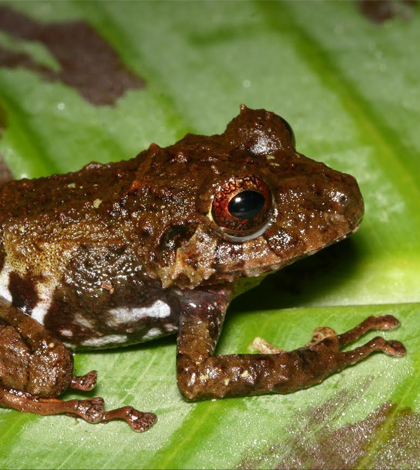Extreme Rains Drop Species Abundance, Diversity Of Tropical Frogs

Pristimantis cruentus, one of the study species. (Credit: Mason Ryan)
Even though tropical frogs live in warm, damp climates, scientists at the University of New Mexico have found that too much rain may not be a good thing for some species.
The researchers joined forces with others at the University of Costa Rica to study the effects of rain on tropical frogs that live in the leaf litter. Their study, coinciding with an extreme La Niña effect that stretched from 2010 to 2012, found that species diversity and abundance of the leaf litter frogs went down dramatically when the rains came. Conversely, the years before the strong La Niña began saw much better numbers for the frogs.
The findings are important because intense El Niño and La Niña events are expected to increase with global climate change, and the survival of similar species may be hurt by all the excess rain.
“If these extreme events become too common, we may be looking at a new norm of higher frequency climatic disturbance,” said Mason Ryan, a doctoral student in biology at the University of New Mexico and the study’s lead author. “If litter frog populations truly are relatively stable under average years, increased frequency of extreme population fluctuations from extreme climatic events may cause problems for some of these species in the long term.”
The species are similar to moisture-loving, aquatic tropical frogs with the exception that they do not rely on water for breeding. And so it was surprising to researchers when they found that the frogs are troubled by rain.

UNM Tropical Biology students sampling a leaf litter plot along with their mascot, the stuffed frog in the tree. (Credit: Mason Ryan)
Researchers set up 10 leaf-litter plots, each about 8 meters square, using PVC pipe for posts and sectioned off with strings. They studied changes in depth of leaf litter, number of tree saplings and the diameter of trees measured at just below 5 feet above ground.
“Tropical leaf litter is a fascinating and complex environment. It is filled with frogs, lizards, snakes, spiders, ants, beetles, and many other organisms,” said Ryan. “All of these organisms are interacting in someway or another.”
Sampling the amphibians themselves was more clear-cut, as scientists got on their hands and knees to remove leaf litter and place it on sheets. When frogs were found, they were placed in containers and held there until the plot survey was complete. At that point, Ryan identified and recorded the species type and number of each frog found.
“In general, little is known about the leaf litter frogs of tropical forests despite it being the most common habitat. On a personal note, I love the brown, non-charismatic frogs of the leaf litter. They can be very abundant, and in other systems very species-rich,” said Ryan. “The abundance and diversity of the litter frogs makes them very important ecologically because they provide an important link in nutrient flows in forests.”
In future studies, Ryan would like to look into that nutrient link. But for now, he notes that this study’s findings — amassed by himself and some 60 other researchers — were completely unexpected.
“We were very surprised by our findings. We found dramatic declines in species abundances and a decrease in diversity during the La Niña,” said Ryan. “Most surprising though was how fast the species diversity increased after the La Niña when rainfall amounts returned to ‘normal.’ Within 12 months, diversity and species abundances returned to the pre-La Niña levels.”
There was one exception to that rebound. The most common frog species before the rain increases had dropped to the second spot in terms of species rank after levels went back to normal, says Ryan.
Top image: Pristimantis cruentus, one of the study species. (Credit: Mason Ryan)





0 comments